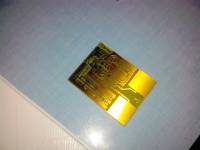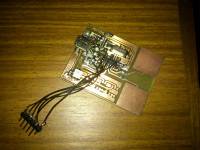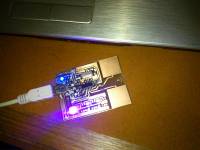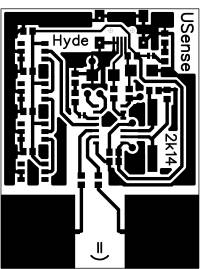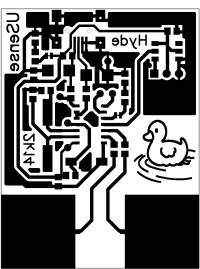# USense
## Overview
Well, this project is a little, quick, and fun one. Basically, the idea was to see what could be done with some RGB leds and capacitive touch inputs.
## Pictures It's all version 1, I unfortunately don't have any picture of the version 2 (but it was better!)
## PCB
Always print the PCB at 600DPI. The text acts as a fool-proof system. It should be readable on your final board. B ### Version 0 Before designing a board, I wanted to try the “capacitive input” stuff, so I designed this quick PCB
### Version 1
First version, used mostly for the firmware development and debug. The actual board is quite messy now, but still works. In this version, I thought I would put four leds on the board, but one was already enough…
### Version 2
I think this is the “Release” version.
## Firmware
### Bootloader
I worked hard to have a USB bootloader to be able to distribute the board, so Micronucleus fires up for 2-3 seconds at power-up. Here's the link: micronucleus-t84.tar.gz
### Test firmware
Since I don't have too much spare time, I only wrote a quick firmware to test the board and be able to give the v2 to a friend.
* The RGB led pulses/fades from one color to another automatically * One capacitive input increases the fading speed * The other decreases the speed * The two combined change the color changing cycle
The archive can be downloaded here: usense_20140907.tar.gz
### Test firmware - Protocol This can be found in include/usense_protocol.h
Messages are 8 bytes long (since it is the limit for wMaxPacketSize for low-speed USB devices)
[ Mode ] [ Val0 ] [ Val1 ] [ Val2 ] [ Val3 ] [ Val4 ] [ Val5 ] [ Val6 ]
* PC > USense *********************************************************
[ 0x01 ] Fade On
[ 0xRR ] Maximum brightness Red
[ 0xGG ] Maximum brightness Green
[ 0xBB ] Maximum brightness Blue
[ 0x02 ] Fade Off
[ 0x03 ] Get Fade
[ 0x04 ] Set Fade Steps
[ 0xVV ] 0x00-020
[ 0x05 ] Get Fade Steps
[ 0x06 ] Set Fade Delay
[ 0x07 ] Get Fade Delay
[ 0x10 ] Set Fixed color
[ 0xRR ] [ OxGG ] [ 0xBB ]
[ 0x11 ] Get LEDs color
[ 0x12 ] LEDs Off
[ 0x20 ] Get Touch
[ 0x21 ] Enable Touch INT
[ 0x22 ] Disable Touch INT
[ 0x23 ] Get Touch INT
[ 0x24 ] Enable Touch ACT
[ 0x25 ] Disable Touch ACT
[ 0x26 ] Get Touch ACT
[ 0x30 ] Get Fade Mode
[ 0x31 ] Set Fade Mode
[ 0x80 ] Reset
* Usense > PC *********************************************************
Usually, it's just an Ack so:
[ 0xRR ] [ 0xAA ]
[ 0xRR ] The request code (see PC > USense)
[ 0xAA ] Ack (0x42) or NAck (0xFF) Value for the previous request
For the "Get" requests, it's an Ack, then the value:
[ 0xRR ] [ 0xAA ] [ 0xV1 ] [ 0xV2 ] ...
[ 0xRR ] The request code (see PC > USense)
[ 0xAA ] Ack (0x42) or NAck (0xFF) Value for the previous request
[ 0xV1 ] ... The returned Value
ex:
Get LEDs color
[ 0x11 ] [ 0x42 ] [ 0xRR ] [ 0xGG ] [ 0xBB ] [ 0xrr ] [ 0xgg ] [ 0xbb ]
in capital letters: Value
in small letters: maximum fvalue for fading stuff
Get Touch
[ 0x23 ] [ 0x42 ] [ 0xVV ] Returns Inputs mask
[ 0xVV ] Touch inputs mask (0b1 means pressed, 0b0 means released)
Special case: for the "INT" messages, the auto-ack is 0x24 instead of 0x42
ex: Touch INT
[ 0x23 ] [ 0x24 ] [ 0xVV ] Touch INT message
[ 0xVV ] See above
### Firmware ideas
When I made the board, I was convinced you could do something actually useful with it… Here are a few ideas:
* Input device with visual feedback (both RGB and Status led), like a morse Keyer or something
* Music/Media control
* Notification LED you can actually dismiss by hardware (for emails, Skype, IRC, …)
* Mood lamp, zen/ambiant visualization for a small room
* Write an HTTP API and make it available from the Internet, so other people can visually _communicate_ with you
* Sound-reactive visualization
* … Up to you ![]()

